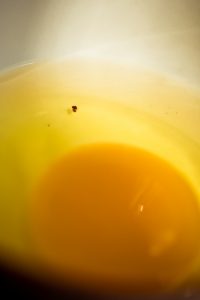Have you ever cracked open a farm fresh egg, only to find a strange little brown blob on it?
It is called a “meat spot,” and as off-putting as that name may sound, a meat spot is actually an indicator of freshness.
A meat spot looks like an irregularly shaped brown/red speck. It is always found inside the albumen, or white of the egg. A meat spot does not indicate a fertilized egg. Meat spots can and will occur in non-fertilized eggs. The odd speck is a piece of tissue that accidentally attaches to the egg while being formed in the hen’s oviduct.
You may also occasionally find a blood streak, which is different from a meat spot. Blood streaks are always attached to the egg yolks. They occur from tiny blood vessels accidentally erupting inside the egg during its journey through the hen’s reproductive system.
If you’re wondering why you never found one of these icky little surprises inside a store bought egg, here’s why:
The older the egg, the higher the chance of the meat spot being re-absorbed into the egg. As the egg ages, the color fades from the meat spot, making it almost invisible. Store bought, white shelled eggs usually come from large chicken layer farms. These farms candle their eggs before selling, and will discard any with abnormalities. White Leghorns are the breed of choice for high producing farms. The egg shells of a leghorn are always white, which make candling and spotting discoloration easier than with darker shelled eggs.
In addition to making candling more difficult, dark shelled eggs tend to have much higher instances of meat spots. While the cause is still relatively unknown, research from the National Health Institute has found 18% of brown eggs will contain meat spots. In comparison, white shelled eggs will only have a 0.5% chance of getting meat spots.

More pigment and protein are needed to create a darker shell, and may contribute to the occasional unappealing bits. In fact, the egg I used for this photograph, came from one of my Marans. I LOVE my Midnight Majesty Marans; they are friendly and lay beautiful eggs. However, true to science, they do tend to have more meat spots than the others.
Other factors can contribute to a higher occurrence of meat spots. Temperature, age of the hen, and diet can all be factors. Hens that have a richer and more varied diet (like our free-range girls), tend to have more meat spots in their eggs.
According to the USDA, meat spots are safe to consume if properly cooked.
You should, however, never eat eggs with an egg white with a strange odor, or with a red, pink, or green tint to them.
Collect your eggs daily, and try not to allow a broody hen to sit on eggs you plan on consuming (if you have a rooster).
If you’re like me, the sight of one of those meat spots can be a little too much! The good news is they can easily be scooped out of the egg, and the rest can still be used for cooking.